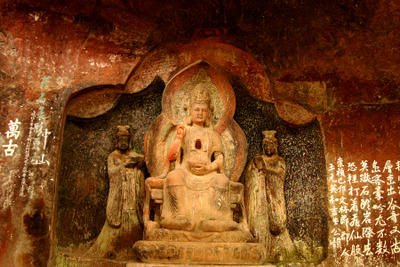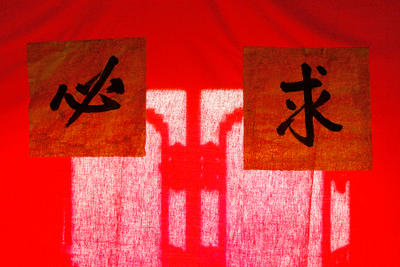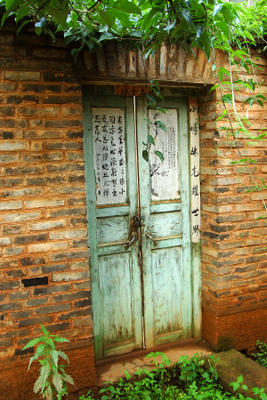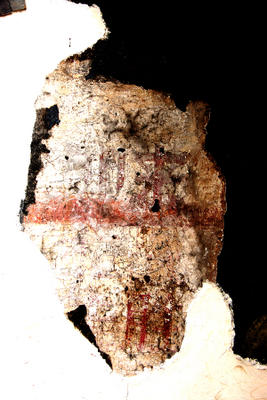Shibaoshan Excursion
27 September 2005
Next weekend is the start of our October break for National Days celebrating the birth of "the New China” in 1949. We plan to head out for the week to hike and travel north through the Tiger Leaping Gorge and onwards to Zhongdian, which marks the edge of Tibetan culture. All to say that there may not be any new posts for a couple of weeks after this one, though I will try to put up one more later this week.
Last weekend we celebrated the “Old China” with a trip to Shibaoshan (sure – bow – shan), a temple complex two and a half hours southwest of here that includes rare remnants 9th century Tang Dynasty stone carvings. One of the most heartbreaking aspects of modern China is the thoroughness with which over 5000 years of history was erased during the several years of the cultural revolution, so it is unusual to see incredible undamaged carvings like the ones at Shibaoshan. The area also includes Buddhist temples that are well-reconstructed versions of the old ones and, of special interest for Bei, large troupes of monkeys that scamper over the cliffs and temples en masse.
We spent Saturday afternoon exploring the three main temple sites and then slept in the small ancient village of Shaxi, nestled in a mountain valley below the temple mountain and surrounded by rice paddies. Sunday we explored Shaxi and then caught buses back to Lijiang in time to get our class preparations done.
The area is probably better shown with photos than with descriptions and here are some from our weekend:
This is the main temple site, built into this sandstone cliff overlooking a mountainous area dotted with shrines and other sites. A long stone staircase led through deep mossy woods to this place where monkeys outnumber people.

These Buddhas keep watch over monkeys and visitors.

Ellen keeps remarking that it feels like fall here. The weather is warm, the leaves aren't changing and at 25 degrees north latitude the sun isn't very low in the sky, so I think it must have to do with all of the red chilis hanging on people's balconies, the corn stalks drying in the fields and the last blooming sunflowers nodding their seed-laden heads. This is a typical sight here--ristras hung to dry. One forgets for a moment that this isn't Santa Fe.

Bei was delighted to have the chance to ride a horse up to the temple. We were told that it was a 1-hour hike and the thought of carrying Bei led us to the horses. The walk turned out to be a short 15 minutes but Bei had a nice ride and the horse owners made an hour's wage in a quarter of the time. In the end we were all happy.

The monkeys were all over the place. The males kept a cautious watch while the mothers showed us their babies.

One of the 9th century (or older) stone carvings. The characters on either side are apparently by a 15th century poet.

The grand views of the temples and statues are interesting but it is the details hidden in abandoned rooms or behind buildings that always capture my attention. This scene was off to the side of the main temple area.

And this is an adobe wall in Shaxi, the village where we spent a night.

This linen hanging was in a room in the main cliff temple. I think the characters mean to keep seeking.

This idyllic doorway was in the old part of Shaxi.

A wall in Shaxi.

Another wall in Shaxi -- layers of plaster peel away to reveal old plaster and faded characters.

A seldom used table saw at the temple.

A strange arrangement of brick, wall and stick near the stone carvings.

Next weekend is the start of our October break for National Days celebrating the birth of "the New China” in 1949. We plan to head out for the week to hike and travel north through the Tiger Leaping Gorge and onwards to Zhongdian, which marks the edge of Tibetan culture. All to say that there may not be any new posts for a couple of weeks after this one, though I will try to put up one more later this week.
Last weekend we celebrated the “Old China” with a trip to Shibaoshan (sure – bow – shan), a temple complex two and a half hours southwest of here that includes rare remnants 9th century Tang Dynasty stone carvings. One of the most heartbreaking aspects of modern China is the thoroughness with which over 5000 years of history was erased during the several years of the cultural revolution, so it is unusual to see incredible undamaged carvings like the ones at Shibaoshan. The area also includes Buddhist temples that are well-reconstructed versions of the old ones and, of special interest for Bei, large troupes of monkeys that scamper over the cliffs and temples en masse.
We spent Saturday afternoon exploring the three main temple sites and then slept in the small ancient village of Shaxi, nestled in a mountain valley below the temple mountain and surrounded by rice paddies. Sunday we explored Shaxi and then caught buses back to Lijiang in time to get our class preparations done.
The area is probably better shown with photos than with descriptions and here are some from our weekend:
This is the main temple site, built into this sandstone cliff overlooking a mountainous area dotted with shrines and other sites. A long stone staircase led through deep mossy woods to this place where monkeys outnumber people.

These Buddhas keep watch over monkeys and visitors.

Ellen keeps remarking that it feels like fall here. The weather is warm, the leaves aren't changing and at 25 degrees north latitude the sun isn't very low in the sky, so I think it must have to do with all of the red chilis hanging on people's balconies, the corn stalks drying in the fields and the last blooming sunflowers nodding their seed-laden heads. This is a typical sight here--ristras hung to dry. One forgets for a moment that this isn't Santa Fe.

Bei was delighted to have the chance to ride a horse up to the temple. We were told that it was a 1-hour hike and the thought of carrying Bei led us to the horses. The walk turned out to be a short 15 minutes but Bei had a nice ride and the horse owners made an hour's wage in a quarter of the time. In the end we were all happy.

The monkeys were all over the place. The males kept a cautious watch while the mothers showed us their babies.

One of the 9th century (or older) stone carvings. The characters on either side are apparently by a 15th century poet.

The grand views of the temples and statues are interesting but it is the details hidden in abandoned rooms or behind buildings that always capture my attention. This scene was off to the side of the main temple area.

And this is an adobe wall in Shaxi, the village where we spent a night.

This linen hanging was in a room in the main cliff temple. I think the characters mean to keep seeking.

This idyllic doorway was in the old part of Shaxi.

A wall in Shaxi.

Another wall in Shaxi -- layers of plaster peel away to reveal old plaster and faded characters.

A seldom used table saw at the temple.

A strange arrangement of brick, wall and stick near the stone carvings.


0 Comments:
Post a Comment
<< Home